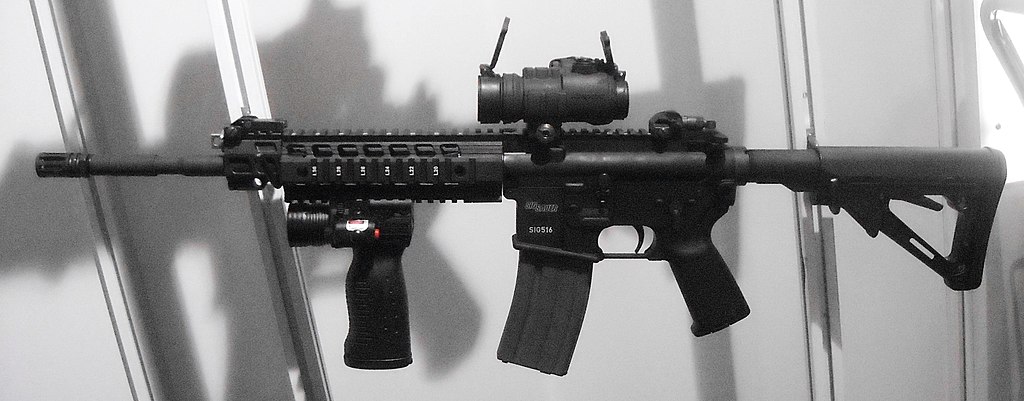
India Looking to Alternative Arms Suppliers Because of Delays From Russia
By Matthew Stein

The next generation M4 rifle from Swiss Arms, the Sig Sauer SG 516 is a newborn assault rifle manufactured by the SIGARMS GmbH, Switzerland. The rifle is based on an American-made Colt Defense M4 Carbine but combined with gas piston/op-rod system, based on the SIG 550 series system.
“This deficit surfaced visibly in the inability of the Indo-Russian Rifles Private Limited (IRRPL) joint venture (JV), instituted in late 2021, to deliver the first batch of around 5,000 AK-203 7.62x39mm rifles to the Indian Army, by March 2024.”
Russia’s invasion of Ukraine and the impact on the Russian defense industry’s deliveries of weapons and equipment to numerous countries, including India, is well documented.[i] The accompanying excerpted article from the independent news website The Wire reports on a Russian-Indian joint venture failing to meet an early 2024 delivery deadline of a batch of assault rifles for India’s Armed Forces. While this marked a small item that Russia has failed to deliver to India compared to the larger systems that have been delayed, the article notes that India has already found an alternative. The article reports that the Indian Army recently acquired 73,000 SIG Sauer rifles from the United States, similar to a purchase of SIG Sauer rifles a few years ago to meet a short notice operational requirement.[ii] The article notes delays of a few other Russian systems, including two S-400 [R1] surface-to-air missile systems and two guided missile frigates. India is not likely to quickly find alternatives to the S-400s or frigates, considering the cost and delivery timeline for these types of systems. However, India’s purchase of SIG Sauer rifles shows that it is willing to look for alternative partners whenever possible.
Sources:
Rahul Bedi, “Russian Rifle Delays Raise Concerns Over Deliveries from Moscow,” The Wire (an independent English-language news website), 15 December 2023. https://thewire.in/security/indias-assault-rifle-induction-woes-continue-with-delays-in-indigenous-ak-203-production
Delays in the indigenous licensed manufacture of Russian Kalashnikov AK-203 [R1] assault rifles at a dedicated facility in Korwa near Amethi in Uttar Pradesh, has further raised concerns in domestic military circles over Moscow’s ability to deliver assorted contracted-for platforms and other materiel to India on time, or if at all.
Despite the sanguinity expressed periodically by Russian officials and diplomats to their Indian counterparts – over the fact that their military-industrial complex remained robust and was ‘on stream’ to vindicate its equipment delivery schedules, US-led sanctions on Moscow for invading Ukraine have, in reality severely jeopardised its capacities in this regard.
This deficit surfaced visibly in the inability of the Indo-Russian Rifles Private Limited (IRRPL) joint venture (JV), instituted in late 2021, to deliver the first batch of around 5,000 AK-203 7.62x39mm rifles to the Indian Army, by March 2024. Instead, at the Indian Army’s prompting, the Ministry of Defence recently approved the add-on import of around 73,000 ‘Patrol’ Sig Sauer assault rifles from the US…
No official statement on this postponement in supplying the AK-203s to the Indian Army units has been forthcoming, from either IRRPL, the Indian Army or the Ministry of Defence. But industry sources said that the economic and technological sanctions on Russia, were together responsible for deferrals in even an industrially low-end project entailing the licensed manufacture of assault rifles. The IRRPL was formed, amidst much fanfare, to manufacture some 750,000 AK-203 rifles…
Russia’s defence industrial complex seems to concur, as it recently conceded its inability in continuing to deliver military kit to its many clients, including India, as it needed to prioritise ‘manufacturing and supplying products to the Russian Army’…
Meanwhile, apart from the deferred AK-203 project, India has three other major Russian platforms on order, all of which were plagued by delays, and possibly an ambiguous future.
These included the delivery of two of five Almaz-Antey S-400 Triumf self-propelled surface-to-air missile systems, acquired for the Indian Air Force (IAF) in a deal signed in October 2018 for $5.5 billion, constructing two Project 1135.6M Admiral Grigorovich guided missile frigates worth an estimated $950 million at Russia’s Yantar Shipyard at Kaliningrad…Between 2021 and March 2023 Russia had delivered three S-400 systems, and Rosonboronexport’s Mikheyev had recently told the country’s state-owned news agency TASS, that the remaining two air defence systems would arrive by end-2023, which has not happened…
Notes:
[i] For more information on Russian military equipment delays to India since the war in Ukraine began, see: Matthew Stein, “India Takes a Step Away from the Russian Defense Industry,” Journal of Indo-Pacific Affairs, 31 July 2023. https://www.airuniversity.af.edu/JIPA/Display/Article/3475660/india-takes-a-step-away-from-the-russian-defense-industry/
[ii] See: Matthew Stein, “Bypassing the “Make in India” Initiative,” OE Watch, May 2020. https://community.apan.org/cfs-file/__key/telligent-evolution-components-attachments/13-21393-00-00-00-35-96-47/2020_2D00_05_2D00_01-Bypassing-the-_1C20_Make-in-India_1D20_-Initiative-_2800_Stein_2900_.pdf?forcedownload=true
Image Information:
Image: The next generation M4 rifle from Swiss Arms, the Sig Sauer SG 516 is a newborn assault rifle manufactured by the SIGARMS GmbH, Switzerland. The rifle is based on an American-made Colt Defense M4 Carbine but combined with gas piston/op-rod system, based on the SIG 550 series system.
Source: https://commons.wikimedia.org/wiki/File:SIG_SG_516_14.5%E2%80%B3.jpg
Attribution: CCA 3.0
Distribution A: Approved for public release
Categories:
Tags:







